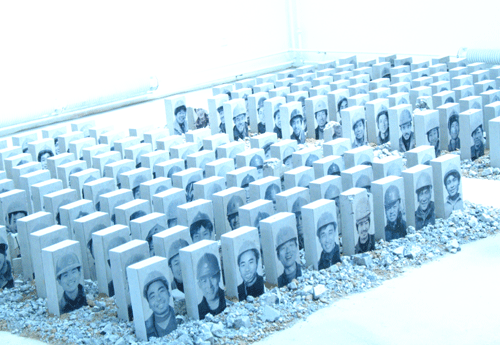By Fan Junmei
China.org.cn staff reporter

Wen Fang, a young photographer who cherishes China's tradition, always bears social reality in mind. Herein Pairs-Beijing Photo Gallery, she astonishes the audience with her innovative and inspiring use of cement bricks. The theme of this exhibition is Foundations, an expansion on her series The New Golden Brick unveiled at Pairs-Beijing Photo Gallery last year.
The exhibition spans from June 21 to August 13, 2008. This elegant artist explained her unique idea on photography in great patience. From her representations of migrant workers as terracotta soldiers, to her revamped version of traditional mahjong, Wen Fang raises questions about the present and future identity of China while honoring the community and culture she deeply cherishes. But what touches the reporter most is her view on migrant workers. It has become a perception that migrant workers in cities are poor groups who deserve more care from the society. Wen Fang, however, said that if we group them as "poor group", this judgment might come from a sense of superiority, thus considering them inferior, it's unfair. Actually, sometimes they are much happier than the rich, the "superior", because they do enjoy and appreciate life as what it is.
It is noteworthy that nearly all the worker images on the cement bricks are smiling. It seems that they do have their own happiness which might not be understood by others at all. Wen Fang said that every time she took photos of the workers, she would try to catch the smiling moment -- life is tough, but optimistic forever.

300 portraits of workers printed on cement bricks
Let's appreciate her works and share her stories.
The Golden Brick: Mahjong
When traced back to early times, there is a long relationship between bricks and mahjong. Walking down street of Beijing, you can hear the voices of mahjong players starting a game, 'Let's build the Great Wall!"
Mahjong is a game of Chinese origin that is usually played by four people with tiles resembling dominoes, bearing four designs. Of 136 tiles, there exist three suits; dots, representing coins; bamboo, representing string holding the coins together; and characters, of which each represents ten thousand coins. The set also contains tiles representing wind (north, south, east, and west) and three colors (red, green, and white), which have the greatest possibility of transforming a mediocre hand into a substantial win.
Mahjong is a considerable part of Chinese lives, as it seems to materialize Chinese wisdom. The value of Mahjong pieces are more or less the same. Tiles are drawn, lined up in a row resembling the Great Wall, and discarded until one player wins the round by creating a standard mahjong hand consisting of a certain number of melds. There are many ways to win; thus, the winning hand depends entirely on timing, decisions, and more than anything else the relations with the other players.

In the New Golden Brick: Mahjong, the three traditional suits are replaced by tiles representing "Wealth (dots)", "Food (bamboo)", and "Lust (characters)". The traditional wind and colors pieces are substituted for cultural icons. Most of the time, "Wealth", "Food", and "Lust" are the most important pieces; however, in tricky situations, the wind and color pieces can help your hand to win big...
In some views, the point of playing mahjong is to display your military science strategies; but, in the end, it's all just for fun.